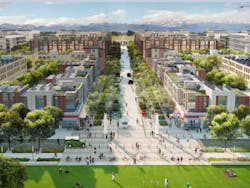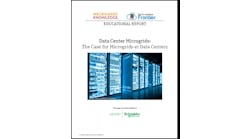Denver’s Peña Station NEXT offers an energy planner’s dream: 382 acres where engineers can start from scratch in creating a clean energy community.
Rendering of Peña Station NEXT. Credit: SevenG
No legacy power plants to accommodate, no wires and poles and substations to navigate — the open landscape near Denver International Airport is a rare find in a nation with near ubiquitous electric infrastructure.
Located near a transit station by the same name, the smart energy community is being planned by a powerhouse team that includes technology giant Panasonic, local utility Xcel Energy, the city of Denver and the National Renewable Energy Laboratory.
The team hopes that Peña Station NEXT will offer a community model that they can replicate elsewhere. That’s the dream. Now comes the hard work, moving it into engineering and economic reality.
The first step, an anchor microgrid, is complete, offering energy for a transit station built as a connector between downtown and the Denver International Airport. Nearby is the community’s first building, the national headquarters of Panasonic.
Next, the partners are tackling more complicated steps, trying to figure out how to configure the energy infrastructure for the yet-to-be built community of homes and businesses — and perhaps most significantly, how to pay for it.
Their goals are ambitious.
For one, Peña Station NEXT will try to achieve carbon neutrality — meaning that the community would produce enough on-site clean energy to offset carbon from any central grid power that it uses. Zoned for a population of 50,000 people, the community is likely to employ a combination of renewable energy, energy storage, thermal energy and possibly electric vehicles.
Low-cost path to carbon neutral
“Carbon neutral is a tough standard to achieve. We think the only way to achieve it is with all of the partners at the table working in concert to minimize the costs to the tenants and developers,” said Matthew Crosby, a utility solutions program manager for Panasonic, whose national headquarters is the community’s anchor building.
That leads to the second task — figuring out a workable business model to pay for capital-intensive energy infrastructure that saves customers money and achieves a societal good, all within a privately developed community.
“We want to see what’s possible,” Crosby said. “We want to see the maximum amount of renewable energy available at the site. We want to see how far we can get from a technical standpoint. Then we really want to focus on the business model that can make all of that happen, or some portion of that happen, in the real world.”
As envisioned, private developers would build the homes and businesses within the 382 acres. Xcel Energy would plan, build and operate the energy infrastructure for what the team calls a district energy system.
The goal is to create a business model that minimize costs for the private building developers, with the hope that they will use the savings to manage energy use within the buildings — and achieve even greater savings. Having the utility serve as district energy provider increases the likelihood of achieving this goal, according to Crosby.
The partners are now studying options and expect to release a plan in March or April. If it appears that Xcel Energy can offer the least cost option, the utility will then work with state regulators to refine a business model.
The Peña Station NEXT community will operate under cost recovery principles that avoid one group of customers cross-subsidizing another, Crosby said. So payment for the energy infrastructure would come from customers within the community — not from Xcel’s broader customer base within Colorado.
Getting the business model right
“Whatever business model Xcel develops, it can’t harm customers that live outside of the development. That’s a key principle we are following in our analysis,” he said.
Details are still being worked out, but the utility would likely seek approval to recover costs for the infrastructure through a fee or rate charged to customers within the Peña Station NEXT energy community.
The partners want to create a business model that is not only fair to customers, but also brings a new revenue stream to Xcel. If it works, this part of the project, alone, could prove to be a national model. Utilities in several states are searching for new revenue sources as they brace for loss of electricity sales to customer on-site generation.
Panasonic, which acted as EPC contractor for the anchor microgrid, hopes to provide energy technology for the 382-acre community, and then replicate the approach for other smart city developments in the U.S.
“We think there is a business case for smart city here, with energy as the fundamental driver,” said Crosby.
Panasonic envisions development of the Peña Station NEXT community taking about a decade. But it could occur sooner if a single developer builds the real estate, as opposed to several, Crosby said.
It’s not clear yet whether the entire community will act as an islandable entity, a very large microgrid, but the idea will be explored, he said.
Peña Station NEXT “matters for society”
NREL, a research branch of the U.S. Department of Energy, is supporting the plan with technical assistance. As part of the study, NREL researchers are modeling building energy consumption and the dynamic flow of high concentrations of various distributed energy resources within the entire district.
More specifically, they are modeling energy consumption of corporate office space, retail space, multifamily dwellings, a hotel, parking, and street lighting within the planned development. The data will then be integrated into Xcel Energy’s grid distribution modeling tools to help the utility analyze possible rate or payment structures.
Juan Torres, NREL’s associate laboratory director for energy systems integration, says that Peña Station NEXT offers the agency an opportunity to work within a “shared vision for clean, affordable, and reliable energy systems at a pace and scale that matters for our society.”
Follow the progress of Denver’s Peña Station NEXT by subscribing to the Microgrid Knowledge newsletter. it’s free.







